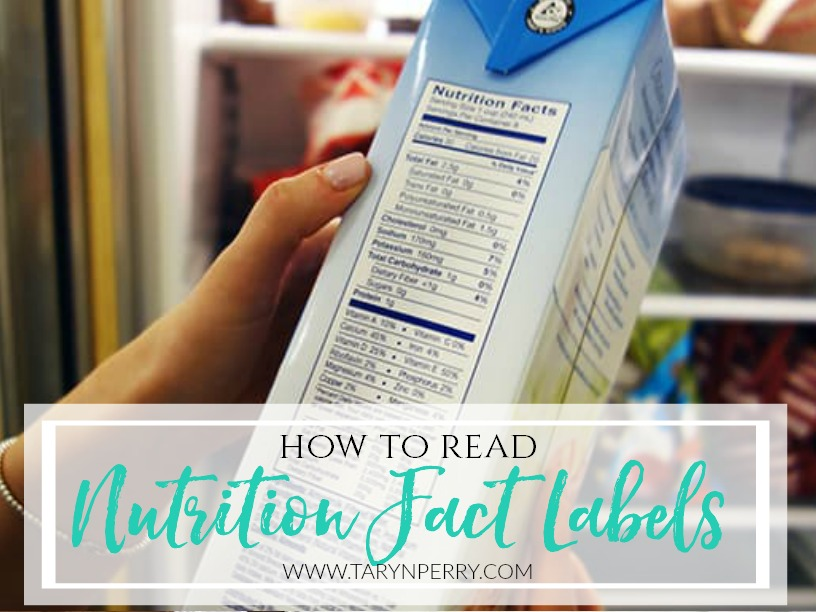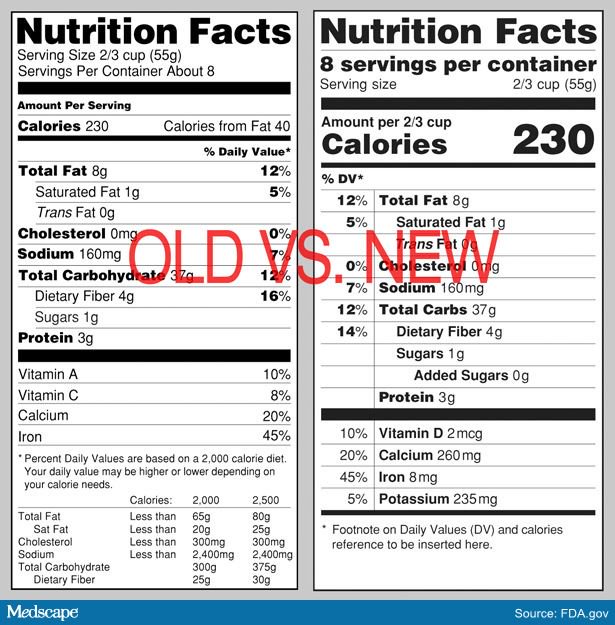How to Read Nutrition Labels
The 411 On Nutrition Fact Labels
It's no secret that looking at food labels can be super confusing, especially if you are new to trying to read and understand what it all means. Think about it this way: The front of a package is marketing. The words on the front, “healthy,” “fat free,” “naturally sweetened,” sound good, but the real information is on the back or on the side. You know not to judge a book by its cover, so don’t judge a cereal box that way either. Today I am going to break it all down for you so that way you can be best equipped to tackle the label your next trip to the grocery store!“Typically you can’t know much about a product by simply looking at the package itself,” says Keri Gans, R.D.N., C.D.N., author of The Small Change Diet. “However, when you read the nutrition label, important information is revealed.”All right, let's dig in here! I am a total nutrition nerd so bare with me.
The FDA regulates most food labels, except for meat and poultry, which are regulated by the USDA and the FSIS. According to the FDA, a Nutrition Facts label is voluntary for “raw produce (fruits and vegetables) and fish.” However, a food label is required on most food packages, with a few exceptions, including “foods that provide no significant nutrition such as instant coffee and most spices.” Beer, wine, and alcoholic spirits are also not currently required to have Nutrition Facts labels, though this law may be changing soon.
Nutrition Facts labels are in the process of being updated. Serving sizes will be adjusted to reflect more typical eating habits, the required vitamin list is changing, calories from fat is going away, and added sugars will be called out. All changes must be rolled out by the end of July 2018 (July 2019 for small companies).
How to Read a Nutrition Facts Label
There are many pieces of information contained within the Nutrition Facts label. Let’s break them down:Ingredients
Though this information is listed at the bottom of the nutrition label, it’s the best place to start. Reading it first might even save you time, because depending on what ingredients are included, you might not want to bother reading the rest of the label.What to look for:
- Short ingredient lists — “Ideally the shorter the list, the better,” says Gans. However, don’t toss a food product because its ingredient list is long as some products are packed with a lot of wholesome ingredients. But if you’re reading an ingredient list for bread and it has 30 ingredients, consider putting it back on the shelf.
- Recognizable ingredients — If you are familiar with all of the ingredients on a list — and they’re all healthy — that’s great. But Gans says, “just because you don’t recognize an ingredient doesn’t mean it should be avoided.” For instance, ascorbic acid might sound scary, but it’s actually just vitamin C.
- Sugars — Sugar is a recognizable ingredient, but it’s one to be mindful of. Many times sugar may be naturally occurring in a food such as strawberries, so it would not be a listed ingredient, but common sense tells us that it does in fact contain sugar. New laws around nutrition labels have made it so companies do have to disclose "hidden sugars" in sweeteners in all product nutrition labels.
Serving size
After you read the ingredients, look at the serving size. The numbers on the label are for one serving. It’s important to look to see how large a serving size is, as often there are multiple servings per container. A bag of chips might contain upwards of 11 servings, whereas most sodas and sports drinks contain two or two-and-a-half servings per bottle. This makes a huge difference in knowing the actual caloric intake for particular foods. And remember, serving size is not indicative of healthy portion size.Calories
The number of calories listed is the number of calories per serving. Going back to the chip example, 150 calories for a serving of chips might not sound terrible, but it’s important to be honest about how many chips you’re really going to eat because there are a mere 11 chips in one serving.Fat
“Fat keeps us full and makes food more satisfying,” says Paige Bente, R.D. and manager of nutrition at Beachbody. That’s because fat digests more slowly than carbs or protein and, as a result, helps you feel fuller for longer. Also, when you eat foods high in fat, the body signals the brain that it’s a satisfying food and that you don’t need to eat that much of it. Unfortunately, the salt and sugar we add to these foods can override these signals.Bente recommends getting roughly 30 percent of your daily calories from fat. That equates to 40 grams on a 1,200-calorie diet, and 60 grams on an 1,800-calorie diet.
Some examples of foods high in healthy fats include: avocados, olives, unsalted nuts, seeds, olive oil, and cold-water fish.
What to look for:
- Trans fat — This number should be at zero since trans fat can lower good cholesterol and raise bad cholesterol.
- Saturated fat — Saturated fats come primarily from animal sources including meat and dairy. The 2015–2020 Dietary Guidelines for Americans recommends limiting this to no more than 10 percent of your daily calorie intake. To determine the percentage of saturated fat in your diet, multiply the gram number by 9 and divide by your total calories consumed.
Total Carbohydrates
On the Nutrition Facts label, Total Carbohydrates includes dietary fiber, sugar, complex carbohydrates, and non-digestible additives. If you look below Total Carbohydrates, you’ll see Dietary Fiber and Sugars are broken out (and on the new food label, Added Sugars will be as well). If you’re looking for net carbs, just subtract the fiber from the Total Carbohydrates.What to look for:
- Dietary fiber — Fiber is an important part of a healthy diet. “Fiber keeps us full; helps to slow the breakdown of carbs and keeps our blood sugar stable; helps us go to the bathroom; and helps bring cholesterol down,” says Turoff. The best rule of thumb is 1 gram of fiber per 10 grams of carbohydrates.
- Sugars — Currently, the number includes naturally occurring sugars found in fruit, vegetables, and dairy as well as added sugars like high-fructose corn syrup. New food labels now break down naturally occurring sugars and added sugars. You can look at the ingredients to get a sense of how much added sugar is in a product.
Protein
Protein helps support a healthy weight, build muscle, and stave off hunger. Every meal should have adequate protein, but that doesn’t necessarily mean every food you eat needs to contain protein. The RDA for protein is .36 grams per pound, which is approximately 54 grams of protein for a 150-pound person. If you’re exercising regularly, aim for roughly .68 grams of protein per pound (that’s 102 grams if you’re 150 pounds). However, it’s important to note that your body can only utilize about 30 grams of protein in one sitting… just another reason to eat small meals throughout the day.And remember, track how certain protein makes you feel. Sometimes your body may respond differently to chicken vs tofu vs eggs.
Cholesterol
Cholesterol helps the body form cell membranes, acts as a building block for many hormones, and helps the body create acids that break down dietary fat. It has a bad rep because when there’s too much of it in the bloodstream it can build up on arterial walls and restrict blood flow.Since the Nutrition Facts label was last designed, research has revealed that dietary cholesterol (the cholesterol in the food we eat) may not necessarily raise blood cholesterol levels, whereas refined sugar and trans fat may. Aim for less than 300 mg/day.
Sodium
USDA guidelines recommend consuming less than 2,300 mg of sodium per day — but those numbers add up quickly. Processed foods like canned soups and frozen entrees are generally high in salt as are most restaurant dishes.Sodium is important for the body because it helps the body maintain a healthy cellular fluid balance and is critical for muscle contraction. However, it’s very easy to consume too much of it. One trick Bente likes to use is to “make sure the milligrams of sodium are less than or equal to the number of calories in one serving.” In other words, if you eat 2,000 calories a day, this approach will help you consume 2,000 mg (or less) of sodium.
Vitamins
The current nutrition label lists the percentage of the recommended daily value of vitamin A, vitamin C, calcium, and iron in a food product. On the new label, vitamins A and C are no longer required; instead, vitamin D and potassium will be listed alongside calcium and iron, and they’ll be displayed as amounts (micrograms or milligrams) as well as percentages.Fun Facts About the Nutrition Facts Label:
- Though it might seem like it’s been around forever, companies began printing the Nutrition Facts label as we know it in 1994.
- The Nutrition Facts label uses Helvetica Black and Franklin Gothic Heavy fonts.
- You might not be doing quite as thorough a read as you think. Through eye-tracking tests, a study from the University of Minnesota found most people only look at calorie count 9 percent of the time and a mere 1 percent glance at total fat, trans fat, sugar, or serving size.
Blog post reposted from the Beachbody On Demand blog.
Categories
- Nutrition (5)
- coaching (31)
- Fitness Journey (21)
- Shakeology (9)
- Reviews (6)
- Family (5)
- Breastfeeding (6)
- Take the Fitness Challenge (5)
- Recipes (37)
- Free Home Workouts (8)
- Uncategorized (2)
- Programs (11)
- Mommin' (5)
- Freebies (7)
- DIY (3)
- Nutrition (20)
- Motivation (12)
- Resources (5)
- Hormones (7)
- Mindset (2)
- Podcast (35)



0 comments
Leave a comment
Please log in or register to post a comment